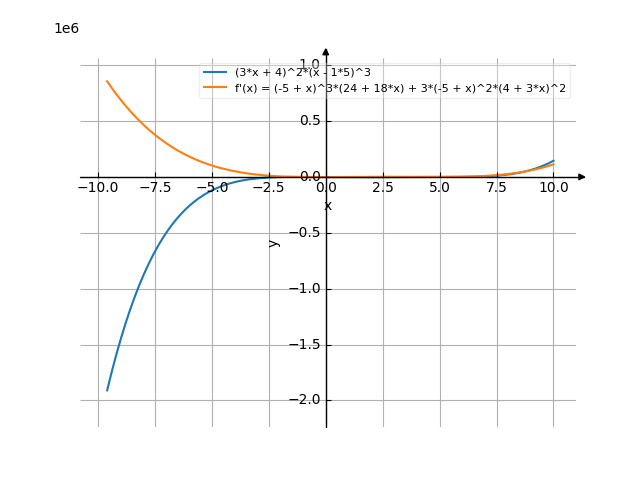Derivative of (3x+4)^2(x-5)^3
The solution
You have entered
[src]
2 3 (3*x + 4) *(x - 5)
$$\left(x - 5\right)^{3} \left(3 x + 4\right)^{2}$$
d / 2 3\ --\(3*x + 4) *(x - 5) / dx
$$\frac{d}{d x} \left(x - 5\right)^{3} \left(3 x + 4\right)^{2}$$
Detail solution
-
Apply the product rule:
; to find :
-
Let .
-
Apply the power rule: goes to
-
-
Then, apply the chain rule. Multiply by :
-
Differentiate term by term:
-
The derivative of a constant times a function is the constant times the derivative of the function.
-
Apply the power rule: goes to
So, the result is:
-
-
The derivative of the constant is zero.
The result is:
-
The result of the chain rule is:
-
; to find :
-
Let .
-
Apply the power rule: goes to
-
Then, apply the chain rule. Multiply by :
-
Differentiate term by term:
-
Apply the power rule: goes to
-
The derivative of the constant is zero.
The result is:
-
The result of the chain rule is:
-
The result is:
Now simplify:
The answer is:
The first derivative
[src]
3 2 2 (x - 5) *(24 + 18*x) + 3*(x - 5) *(3*x + 4)
$$\left(x - 5\right)^{3} \cdot \left(18 x + 24\right) + 3 \left(x - 5\right)^{2} \left(3 x + 4\right)^{2}$$
The second derivative
[src]
/ 2 2 \ 6*(-5 + x)*\(4 + 3*x) + 3*(-5 + x) + 6*(-5 + x)*(4 + 3*x)/
$$6 \left(x - 5\right) \left(3 \left(x - 5\right)^{2} + 6 \left(x - 5\right) \left(3 x + 4\right) + \left(3 x + 4\right)^{2}\right)$$
The third derivative
[src]
/ 2 2 \ 6*\(4 + 3*x) + 27*(-5 + x) + 18*(-5 + x)*(4 + 3*x)/
$$6 \cdot \left(27 \left(x - 5\right)^{2} + 18 \left(x - 5\right) \left(3 x + 4\right) + \left(3 x + 4\right)^{2}\right)$$
The graph


![Find the derivative of y' = f'(x) = (3x+4)²(x-5)³ ((3x plus 4) squared (x minus 5) cubed) - functions. Find the derivative of the function at the point. [THERE'S THE ANSWER!] (3x+4)^2(x-5)^3](/media/krcore-image-pods/176/hash/derivative/9/53/621aadad44e54c440b6c4b7c5ad72.png)
 Derivative of (3x+4)^2(x-5)^3
Derivative of (3x+4)^2(x-5)^3
 Derivative of y=sin^3(4x−1).
Derivative of y=sin^3(4x−1).
 Derivative of x/sqrt(x^2-1)
Derivative of x/sqrt(x^2-1)